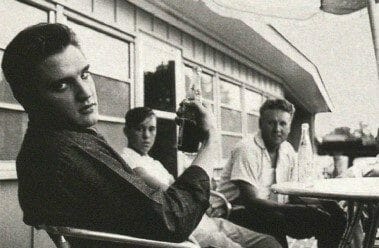Elvis Presley was just 41 when he died in August 1977. So much had been achieved in just over twenty years; a young country boy had risen exponentially to become one of the biggest – perhaps even the biggest – icons of twentieth-century popular culture. Looking back over his career with Gale’s digital archives reveals a more personal, introverted side to the man who became known as ‘the King’.
Early Years
1956 was the year it all began. Aged just 21, a young Elvis had just recorded ‘Heartbreak Hotel’ – a song which remains instantly recognisable to this day. Yet before he became synonymous with boisterous, pelvic-thrusting performances, there was an air of innocence about a boy who had been raised by his parents in rural Mississippi. In a photo shoot commissioned during the summer of 1956 by his record label, RCA Records, Elvis was portrayed as reserved and family-centred.

Taylor, Alina Corday. “Boywonder.” Smithsonian Magazine Aug. 2002: 66+. Smithsonian Collections Online.

At this stage in his career, there was nothing inevitable in his meteoric rise. Before he reached global stardom, it is worth remembering that not all were convinced of his talent. There was, in fact, a noticeable hostility in much of the English press towards the young upstart. His pelvic-gyrating performances were like nothing anyone had ever seen before, and viewed as particularly provocative for scores of screaming teenage girls. Elvis was described by the Daily Mail as a ‘cavorting, crooning 21-year-old idol of the teenagers’, partly responsible for spreading the ‘communicable disease’ of Rock n’ Roll.

“Rock ‘n roll is musical dynamite.” The Daily Mail 4 Sept. 1956: 6. Daily Mail Historical Archive, 1896-2004.
Arise ‘the King’
Like it or not, the ‘disease’ the newspapers reported proved highly infectious. By autumn 1956, Elvis was fast becoming a household name in Rock n’ Roll, having performed live on Ed Sullivan’s hit TV show ‘The Ed Sullivan Show’ in September (an appearance which attracted a staggering 60 million viewers – the largest television audience in history). Sights like the one in the image below – Elvis standing with legs (dangerously) far apart – would soon become commonplace.

“Young Elvis.” News Features & Internal Communications Image Collection. Primary Source Media, 1956. Associated Press Collections Online.
This mass exposure enshrined the figure of Elvis in the popular imagination – at least for younger generations. Each public appearance would be greeted by fanfare on a scale previously unknown, with hordes of screaming fans eager to catch a glimpse of their slick-haired idol. This presented challenges of its own when Elvis undertook his National Service with the US army in 1958. A first-hand account from Associated Press Collections Online illustrates the level of attention the star attracted during his time with Company A at Fort Hood, Texas. Describing his arrival at the barracks in March 1958, three words suffice: ‘it was wild’. The bus carrying Elvis was mobbed in ‘rampant pandemonium’. Yet despite encountering a fair bit of unwanted attention, Elvis successfully completed his two-year stint in the army. Offering another glimpse into the man behind the legend, he was even noted for his ‘outstanding leadership traits’ and ‘fine attitude’. Fame had clearly not quelled his hunger for success in whatever field he applied himself to; he remained humble and determined. On completing his active service in Germany, he resumed his Rock n’ Roll career with renewed vigour, achieving US number-one hits with ‘It’s Now or Never’, ‘Surrender’ and ‘Good Luck Charm’ in the early-60s.

Death and Legacy
But endless years in the spotlight eventually took their toll, and in the 1970s the once ever-present Elvis gradually receded from public life. He came to rely heavily on drugs, which is now well documented (his post-mortem revealed traces of fourteen prescription drugs in his body). This was despite his request, just seven years previously, to assist the Nixon administration in its war against drugs. In December 1970, he had met President Nixon in secret to discuss how he could use his influence on young people to stop the spread of illegal drug abuse. Conversely, drugs were his own downfall.

Despite his unfortunate final years, nothing can take away from the mark Elvis Presley left on twentieth-century culture. His edgy performances and inimitable vocals defined a whole era of music, ensuring his legacy will live on for many years to come. It is fitting, as we approach the 29th anniversary of his death, to look back and reveal some of his lesser-known traits. To see more of the resources listed in this post, register here for a free trial.



